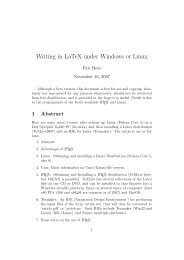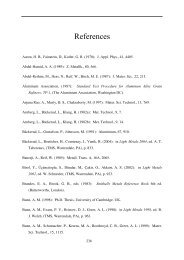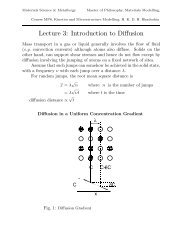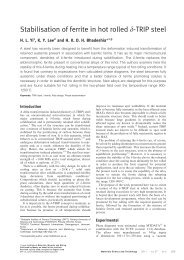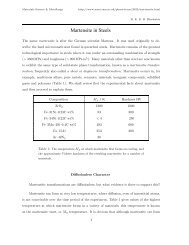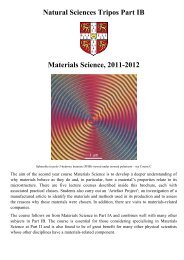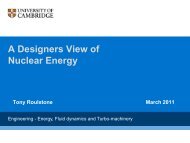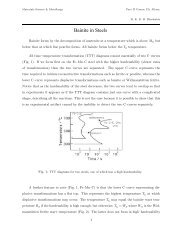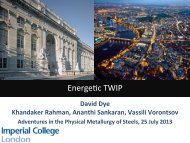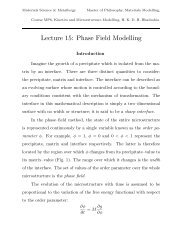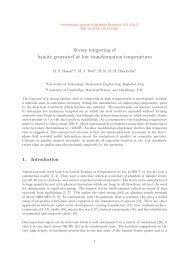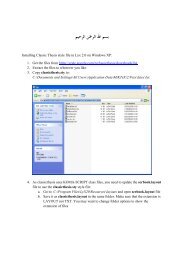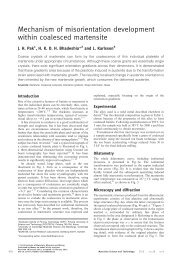Research Profile - Department of Materials Science and Metallurgy ...
Research Profile - Department of Materials Science and Metallurgy ...
Research Profile - Department of Materials Science and Metallurgy ...
You also want an ePaper? Increase the reach of your titles
YUMPU automatically turns print PDFs into web optimized ePapers that Google loves.
Cathie Rae<br />
Lecturer<br />
MA University <strong>of</strong> Oxford<br />
DPhil University <strong>of</strong> Oxford<br />
+44 (0) 1223 334333<br />
cr18@cam.ac.uk<br />
www.msm.cam.ac.uk/utc/<br />
Mechanical Properties <strong>and</strong> Microstructure<br />
Over the last 50 years turbine entry temperatures (TETs) have<br />
risen from 800ºC to 1600ºC. <strong>Materials</strong> developments in all turbine<br />
components, are critical to achieving this, but engine designers<br />
are looking for a TET <strong>of</strong> 1800ºC to increase engine efficiency <strong>and</strong><br />
reduce environmental impact. We focus on underst<strong>and</strong>ing the<br />
fundamental mechanisms determining the mechanical properties<br />
<strong>of</strong> turbine materials <strong>and</strong> use this to produce tools <strong>and</strong> strategies<br />
for materials development <strong>and</strong> life prediction.<br />
Alloy development <strong>of</strong> fourth-generation singlecrystal<br />
alloys<br />
Nickel-base single-crystal superalloys can be strengthened<br />
by the addition <strong>of</strong> tungsten <strong>and</strong> rhenium, but doing so while<br />
maintaining reasonable density, stability <strong>and</strong> environmental<br />
resistance requires careful optimization <strong>of</strong> the composition<br />
<strong>and</strong> microstructure. Our work is aimed at underst<strong>and</strong>ing the<br />
mechanical properties at all temperatures experienced in service<br />
<strong>and</strong> involves creep LCF <strong>and</strong> TMF testing, combined with TEM<br />
<strong>and</strong> SEM <strong>of</strong> the deformed microstructures. In fourth-generation<br />
patented alloys developed at Cambridge, the role <strong>of</strong> ruthenium<br />
in stabilising <strong>and</strong> strengthening the alloys is being investigated.<br />
As part <strong>of</strong> the ‘Alloys by Design’ project, the interactions <strong>of</strong><br />
dislocations with the γ' precipitates are being modelled using<br />
phase-field techniques.<br />
Oxidation <strong>and</strong> coatings<br />
Thermal-barrier coatings are an integral part <strong>of</strong> component<br />
design: underst<strong>and</strong>ing both the oxidation kinetics <strong>of</strong> nickelbased<br />
alloys <strong>and</strong> their long-term interaction with various coating<br />
systems is vital to component lifing <strong>and</strong> future design strategies.<br />
Projects involve the time-dependent oxidation behaviour <strong>and</strong><br />
oxide morphology, <strong>and</strong> the compatibility <strong>of</strong> various coatings with<br />
both commercial <strong>and</strong> experimental nickel-base superalloys. New<br />
methodologies, developed in Cambridge, have been adopted by<br />
Rolls-Royce as part <strong>of</strong> their worldwide component lifing strategy.<br />
RA Hobbs, S Tin & CMF Rae, “A castability model based on elemental<br />
solid-liquid partitioning in advanced nickel-base single-crystal superalloys”<br />
Metall. Trans. A 36A, 2761–2773 (2005).<br />
CMF Rae, MS Hook & RC Reed, “On the precipitation <strong>of</strong> topological close<br />
packed phases at aluminide coatings on superalloys <strong>and</strong> the effect <strong>of</strong><br />
precipitate morphology” Mater. Sci. Eng. A 396, 231–239 (2005).<br />
CMF Rae & RC Reed, “Primary creep in single crystal superalloys: Origins,<br />
mechanisms <strong>and</strong> effects” Acta Mater. 55, 1067–1081 (2007).<br />
The picture shows the nickel-based superalloy TMS82 during<br />
the early stages <strong>of</strong> primary creep showing an a dislocation<br />
ribbon passing through both precipitates <strong>and</strong> matrix<br />
<strong>Research</strong> <strong>Pr<strong>of</strong>ile</strong> 33



